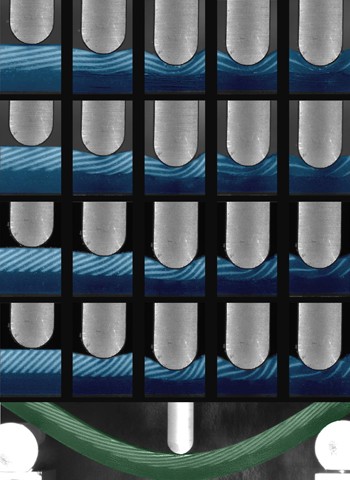Scale Armor: The Future Version
-
Uniforms that function as protective gear and space suits that are both flexible and impervious to micro-meteorites are two of the possible applications for new complex materials developed by the Technion

The various micro-structures (various angles of hard scales and a quantity of the stiff substance) and their reactions to the strength of the penetration; bottom – bending one of the models under pressure, to assess the material’s flexibility
Bulletproof uniforms and space suits impervious to micro-meteorites are two of the potential applications for new materials developed at the Technion Faculty of Aerospace Engineering, states an article in the Soft Matter technology journal. These materials were developed by Assistant Professor Stephan Rudykh, head of Mechanics of Soft Materials Lab. “Flexibility and strength are considered as usually competing properties: as one increases the other decreases. In general, this is true, but in my research I am trying to create materials that will be both flexible and strong (with respect to their penetration resistance).”
Assistant Prof. Stephan Rudykh specializes in creating complex soft materials. He started out as a theorist, but after exposure to the world of 3D printing during his post-doctoral work at Massachusetts Institute of Technology, he started experimenting with various formulas.
“Suddenly I could make the materials that I was designing,” he says, “and then check if their properties match my theoretical projections. Now, too, with these materials, which are flexible and relatively durable against penetration, I can run trials on the models I print.” Rudykh’s research is a joint effort between the Technion and MIT.
Rudykh joined the faculty as an Assistant Professor straight from his post-doctoral studies. His research has already been published in leading journals such as Physical Review Letters and his most recent article was published in Soft Matter.
The inspiration for Rudykh’s development of the new strong and flexible materials comes from fish. “Fish are flexible creatures, but are protected by hard scales. Their ‘secret’ is the combination of the scales and the soft tissue beneath them, and that is what I tried to mimic here. The materials that I am designing are also made of two layers – one soft (the ‘body’) and the other (‘scales’) constitutes the ‘armor’. These two components provide the combined property of protecto-flexibility that we want.”
When asked about possible applications, Rudykh speaks very cautiously. “My job is not to develop applications, but rather to design the material, and my focus at present is the optimization of the material. If, for example, we were talking about army uniforms, or about a space suit against micro-meteorites, then there are areas such as the chest that need hardly any flexibility, and other areas such as the elbow, where flexibility is essential.”
Rudykh stresses that it is extremely challenging to completely counteract the inverse relationship between flexibility and strength, but it is possible to play with the trade-off between them. “I have managed to increase the penetration resistance by a factor of 40, while reducing flexibility by only a factor of 5, and that opens a great many options. Concerning army uniforms or space suits, the idea is to create a tailor-made fabric based on the soldier’s body type and of course the conditions he will be facing. For example, we can think about protection of spacemen against space radiation by incorporating protective materials into the microstructure of the flexible composites.”
The published results are based on quasi static tests on the 3D-printed materials, when materials are loaded relatively slowly. Later, he hopes to do dynamic testing, using fast-moving projectiles such as bullets or small particles – and to examine the results.
Source:http://pubs.rsc.org/en/Content/ArticleLanding/2015/SM/C4SM02907K



